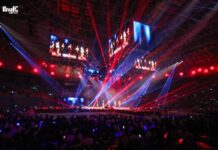
The four boxes that held the royal seal of Heungseon Daewongun, plus the seal itself, are collectively known as the ogae sabibin (오개삽입인, 五個揷入印). They’re intricately formed so that they cover and keep each of the smaller boxes, according to size. Each side of the boxes is carved with words and phrases.
A small cube is on display with four other boxes, open on one side. This relic reminds people of the traditional Russian “nesting doll,” where sets of wooden dolls of decreasing size are placed one inside the other. The sides of the small storage boxes are carved with words and phrases.
This relic, collectively called the ogae sabibin (오개삽입인, 五個揷入印), or the “five boxes that hold the royal seal,” is the royal seal used by Heungseon Daewongun Yi Ha-eung (1820-1898), the father of King Gojong (1852-1919), Joseon’s 26th ruler.

Each month, starting this February, the National Palace Museum of Korea is displaying royal relics from its archives. It begins with the five parts of the royal seal of Heungseon Daewongun.
Starting this February, the National Palace Museum of Korea will have on exhibit one specially selected royal artifact from its archives every month, part of its “Royal relics from museum storage” range of exhibitions. The museum’s first relic is the five cubes that constitute the royal seal used by Heungseon Daewongun.
Unlike other royal seals that were normally carved with words or shapes on the surfaces, this cubic stamp is crafted so as to carefully fit in to each larger box. Each side of is carved with different words and phrases. On the smallest sides, spanning only 1.5 centimeters across, words of greetings used at the end of letters are carved. It says “hobong” (護封), which means “to seal the envelope.” Another side says “baebae” (拜拜) which means “to bow.”
The larger sides, 3.5 centimeters across, have phrases such as “Being happy to have the spring in a tower with apricot blossoms, and the summer at a pavilion next to a pond with lotus flowers” (梅閣留春荷亭銷夏自娛而已).
Though known for his policies of national seclusion, Heungseon Daewongun was in fact a good artist very skilled at calligraphy and painting. He left various royal seals to show his poem and painting abilities.

The smallest cube of the five-piece royal seal is 1.5 centimeters across. Each of its six sides is carved with words or phrases that are used as greetings at the end of letters.
The National Palace Museum of Korea said, “The life of Heungseon Daewongun, which went through ups and downs, is reflected in his works of art. One of the phrases carved on the seal seems to express his true feelings as a human who was tired of the hardships of life. It says ‘I am afraid that others might detest the truth in me’ (畏人嫌我眞).”
By Yoon Sojung
Korea.net Staff Writer
Photos: National Palace Museum of Korea
arete@korea.kr























